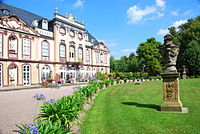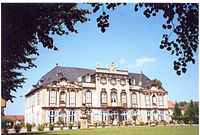Molsdorf Castle
Molsdorf Castle is a baroque castle in Molsdorf , a district of Erfurt . It is not far from the Erfurt motorway junction, about 12 kilometers south of the city and is considered to be one of the most beautiful baroque castles in Thuringia . Today the castle belongs to the Thuringian Palaces and Gardens Foundation . There used to be a dining restaurant in some of the rooms on the ground floor. The castle houses a collection of paintings by the painter Otto Knöpfer .
location
Molsdorf Castle is located in the south of Molsdorf. The original castle complex includes the castle in the center of the complex, the two four-sided courtyards of the estate - later LPG - in the northeast, the church in the northwest and the park adjacent to the south.
| Map of the Molsdorf Castle Park |
history
Time until 1733
A moated castle in the upper village to the left of the church has stood on the site of today's castle since the 16th century . 1114 are the lords of Molsdorf (Erminrich von Molsdorf) mentioned in a document. Later, the lords of Witzleben and von Thüna owned the moated castle (Dietrich von Witzleben, 1432; Heinrich von Witzleben, 1450; Ernst von Witzleben, 1530). In 1616 the town and castle temporarily came into the possession of those von Schwarzburg-Sondershausen , at that time still Count Günther von Schwarzburg-Arnstadt.
The castle was rebuilt into a renaissance castle, which was converted into today's baroque complex in the 18th century. At the beginning of the 18th century, the privy councilor Bachov acquired the estate, who left it to the British and Brunswick Legation Councilor and Landdrost , Otto Christoph Schultz (also Schulze ) .
Count Gotter

In 1733 the imperial count and Prussian ambassador to the Viennese court Gustav Adolf von Gotter acquired the palace from the widow of Schultz ' . In the years 1734 to 1740 he had it transformed into an impressive palace by the builder Gottfried Heinrich Krohne in the Baroque style. The painters Johann Kupetzky and Antoine Pesne as well as the plasterer Giovanni Battista Pedrozzi were commissioned with the artistic design . At the same time, based on the French model, a spacious garden was created in the same style, adorned with a large number of contemporary sculptures. The rear view of the moated castle became the representative garden facade of the baroque castle. The west and east wings were built on top of the filled-in moat. A handsome portal was created between the aligned tower stumps on the north side. Under Krohne's management, not only the garden facade experienced its splendor, but also the representative rooms in the south wing. The complex system exceeded the client's financial means. For his lavish lifestyle and the renovation of Molsdorf he had spent three million thalers in a short time. Despite the support of the Prussian King Frederick the Great and two lottery prizes of several million, he was unable to hold Molsdorf. As early as 1748 he had to sell the castle. He returned to the Prussian court as Oberhofmarschall, where he was appointed imperial count by Friedrich II and sent to Vienna.
According to gods
In 1748, Gotter's successor as castle owner was the Württemberg State Minister, Heinrich Reinhard Freiherr Röder von Schwende , who in turn gave it to Duke Friedrich III for around 80,000 thalers . sold. These owners were also financially overwhelmed. The baroque garden was redesigned into an open landscape park around 1820 at the instigation of the Duke of Saxe-Gotha ; the 150 or so sculptures, which are said to have given him a “princely reputation”, disappeared, only a few have been preserved. Remnants of the baroque garden can still be found on the western edge of the park. A small baroque garden was laid out on the east side of the palace , in which some damaged sculptures are set up as a lapidarium . The Countess von Gneisenau had the castle rebuilt between 1910 and 1922 in the Art Nouveau style . In 1939 the Prussian state bought the castle and grounds, and the Reichsautobahn was built not far from the southern border of the park.
After the Second World War, the city of Erfurt became the legal successor and owner. In the summer of 1945, the palace complex became temporary quarters for a Polish aid organization that looked after Polish refugees and forced laborers returning home. German expellees and refugees followed. In 1948 the castle narrowly escaped the demolition demanded by the Soviet Military Administration in Germany (SMAD). The building then served as a children's home until 1954. The property belonging to the castle grounds was handed over to the newly founded LPG in Molsdorf.
The first restoration work took place in the 1950s. Reconstruction has been going on since the late 1950s. The lost interior was completed with inventory items from expropriated manor houses and country castles in the area (e.g. Friedrichswerth Palace ) with the approval of the state preservation authorities . In 1966 the renovated large ballroom was opened to the public. Comprehensive renovations and modernizations were later carried out throughout the castle (central heating, sanitary technology, electrics, fire protection) and a castle café with a kitchen area was created.
The castle was used as a venue for art and antiques auctions of the GDR's state art trade. Cultural events and chamber music concerts were held here regularly . From 1990 the castle was extensively renovated and then opened for inspection.
today
A tour of the building begins in the buffet room where the festive feasts were arranged. The former banquet hall is entered through a double-leaf door. 33 images of reigning kings, princes, diplomats and generals from the 18th century adorn the oak paneling of the walls, which extends to the ceiling. Peter Weingart created the ceiling painting in 1738, which represents a special technical sophistication: It is supposed to be a table top that can be lowered, with which Gotter astonished his guests again and again. This ballroom is considered unique in Thuringia.
In the silver or ladies' hall that followed, the walls once bore 35 portraits of gods honored women, the "crowned heads of his heart". The marble hall is illuminated by the incidence of light from the large windows and the balcony door, which is broken in the mirrors and portraits. Only a few of the many pictures from this period are still available today. Gotter's bedroom, once decorated with lascivious representations, no longer shows his charm and wealth. Worth mentioning are the paintings Gotter and his niece Friederike von Wangenheim in pilgrimage costume from 1750 by the artist Antoine Pesne and Die Zigeunerin by Johann Kupetzky . The paintings in the marble hall Aurora with the sun chariot (ceiling painting by Pesne) and gods in hunting robes (Kupetzky) also come from the two artists .
The red salon forms the end of the garden facade; It takes its name from the red wallpaper, which comes from the 19th century and from the castle in Seebach . Noteworthy is the ceiling painting by an unknown master, which symbolizes Gotter's philosophy of life: the triumph of the liberal arts over hell and the clergy . In addition, Schloss Molsdorf presents an erotica collection from the 20th century and invites you to regular chamber and park concerts. The castle belongs to the Thuringian Palaces and Gardens Foundation and is open to the public.
literature
- Sabine Schürholz, Günther Thimm: Molsdorf Castle with a park. Deutscher Kunstverlag, Munich / Berlin 1998, ISBN 3-422-06236-X .
- Helmut-Eberhard Paulus: Castle and garden Molsdorf. Count Gotters residence of the Enlightenment. (= Great Art Guide of the Thuringian Palaces and Gardens Foundation , Volume 4.) Schnell and Steiner, Regensburg 2012, ISBN 978-3-7954-2604-0 .
- Molsdorf Castle Museum . Row: Treasury of Thuringia. Leaflet, 12 pages. Edited by Thuringian Palaces and Gardens Foundation and Molsdorf Castle Museum. First edition, 2008
- Molsdorf Castle and Park. Castle Museum . Leaflet, 6 pages. Edited by the Thuringian Palaces and Gardens Foundation and the Molsdorf Castle Museum. 2nd edition, 2015
Web links
- Molsdorf Castle , German Digital Library
- Page about Molsdorf Castle on the private website molsdorf.de
- Thuringian Palaces and Gardens Foundation, Molsdorf Castle
- Molsdorf Castle on erfurt-web
Individual evidence
- ↑ a b c d Ulrich Völkel: Gastliches Thüringen. Verlag Kleine Arche, Erfurt 1993, ISBN 3-929662-00-0 .
- ^ A b Johann Georg August Galletti : History and Description of the Duchy of Gotha. Volume 3. Ettinger, Gotha 1780, pp. 324-325.
- ↑ Michael Köhler: Thuringian castles and fortified prehistoric and early historical living spaces. Jenzig-Verlag Köhler, Jena 2001, ISBN 3-910141-43-9 , p. 184.
- ^ Website of the municipality
- ↑ a b Building files in the Gotha State Archives, Käthe Menzel-Jordan estate
Coordinates: 50 ° 54 ′ 2.4 ″ N , 10 ° 57 ′ 40.7 ″ E





